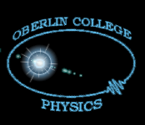
A Few Oberlin College Astronomy Highlights
Astronomy has been a part of the "natural philosophy", or
physics curriculum since the founding of the college in 1835. In
the mid-1800's, Charles Churchill, came to the college with a
background at Alvan Clark's telescope making firm, the premier
refractor telescope maker of the 19th and 20th centuries. Alvan
Clark donated a 5" refractor telescope for use by Churchill in
his teaching, which remained at the college until at least the
1920's. During the late 19th and early 20th century, observing
was a significant part of the astronomy curriculum at Oberlin.
During the 1920's, no class observing was done because of the
condition of the old telescope and the observatory dome.
Many Oberlin students and professors have made significant contributions to astronomy. Henrietta Swan Leavitt, a student at Oberlin from 1885-1888 went on to work at Harvard, where, as a 'calculator', she defined the standards for measuring star luminosity with photography, and went on to discover and describe behaviors in Cepheid variable stars that gave us the first "measuring stick" by which to gauge the size of the universe.
Charles St. John came to teach astronomy at Oberlin in 1897, spending his summers at Yerkes observatory, and improving the astronomy facilities at Oberlin. St. John left in 1908 to join George Hale in establishing the solar program at Mt. Wilson. St. John worked on measuring the gravitational red shift of our sun from the Mt. Wilson facility, attempting to confirm Einstein's theories.
Ira S. Bowen graduated from Oberlin in 1919(?) and went on to work for Oberlin graduate and Nobel Laureate Robert Millikan at Chicago and the California Institute of Technology. In 1928 Bowen explained the nature of the spectra of gaseous nebula in space, which earned him the Bruce Prize in 1957. Bowen served as Director of the Mt. Wilson Observatory from 1946, and directed both the Mt. Wilson and Palomar Observatories from 1948 until 1964. He oversaw completion of the 200 inch Hale telescope at Palomar, and designed and oversaw construction of many of the instruments at these two major facilities.
There are currently many Oberlin graduates working as professional astronomers, including several in NASA's Chandra X-ray observatory program.
The current Oberlin College observatory was constructed in 1929 on a tower that Charles Churchill had planned for that purpose on the top of Peters Hall, constructed in the 1880's. From 1898 to 1929 a "temporary" dome made of painted canvas over a wooden frame served that purpose in the same location. Also in 1929, a new Gaertner 6 inch refractor telescope replaced a similar aperture telescope donated by Kenyon Cox (uncle of the artist by the same name) in 1871, which had been worn out from long use. That telescope was replaced by a modern instrument capable of carrying and tracking long photographs with a CCD camera in 1991. The Gaertner 6" was refurbished and now resides in a dome built specifically for it by an amateur astronomer and antique telescope collector in Colorado. In 2001, the Oberlin observatory telescope was again upgraded to a larger 14 inch aperture model with much improved tracking accuracy, improving imaging capability for both visual and CCD work.
In 2001, observing once again became a regular introductory
astronomy lab activity, and 5 smaller telescopes on piers were
installed on the observing deck so that students would have the
opportunity to observe a number of objects at each session
without spending most of their time standing in line waiting for
a view. This is part of an ongoing effort to improve and upgrade
observing facilities and opportunities at the college.
